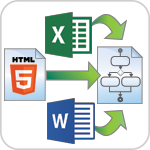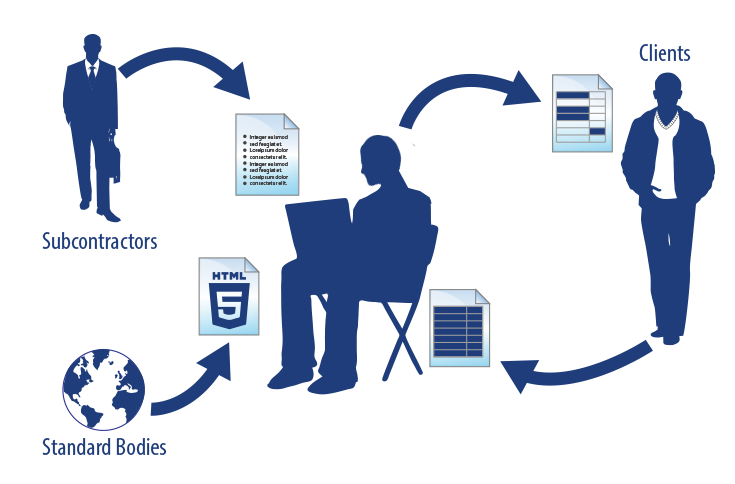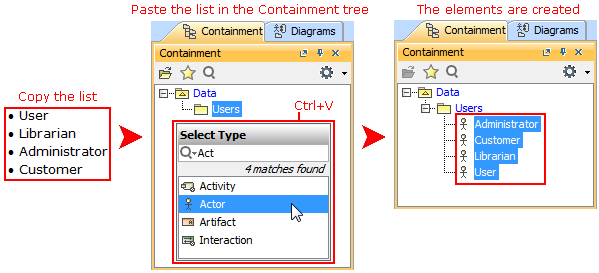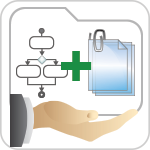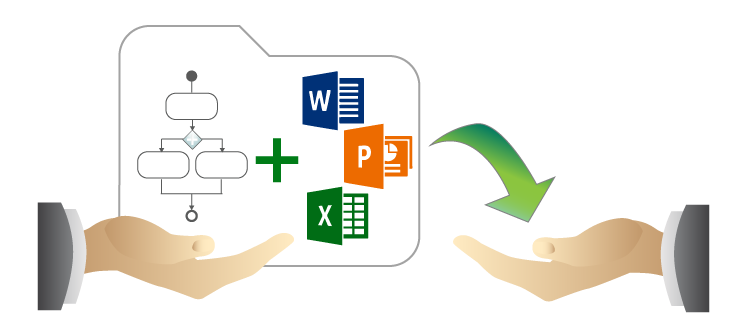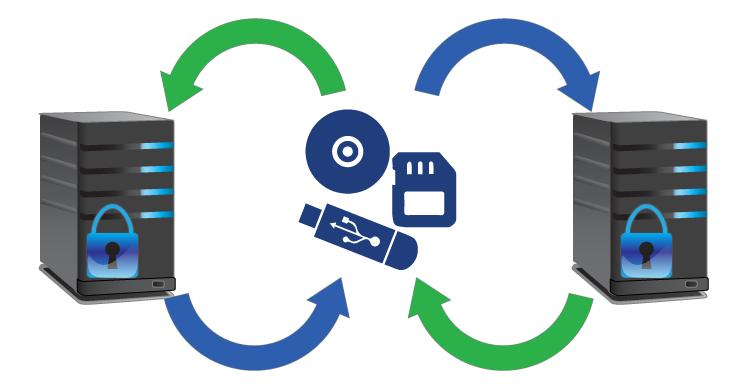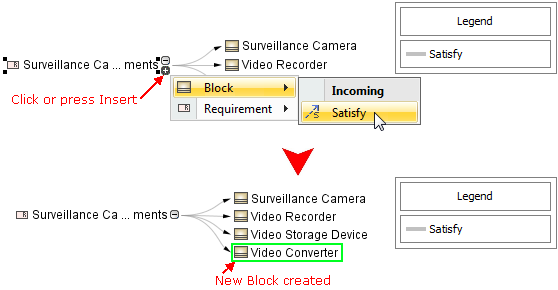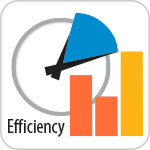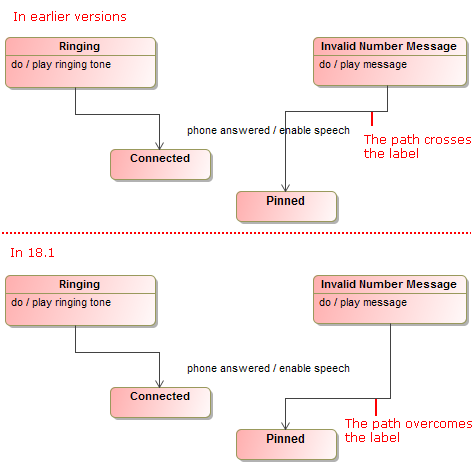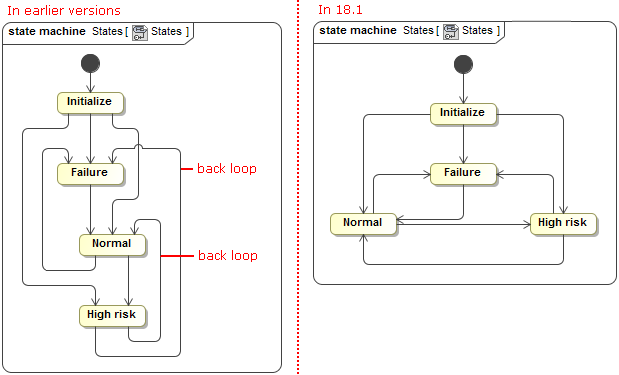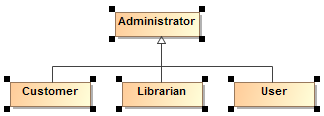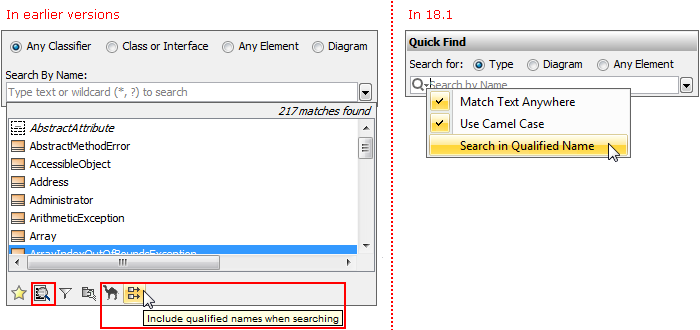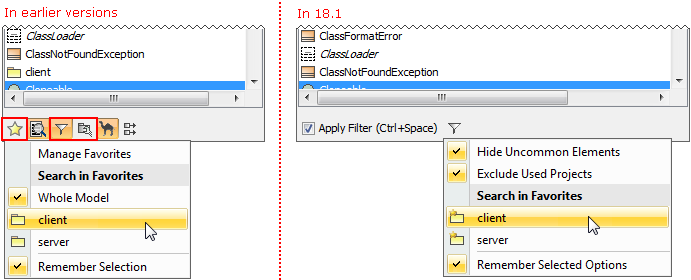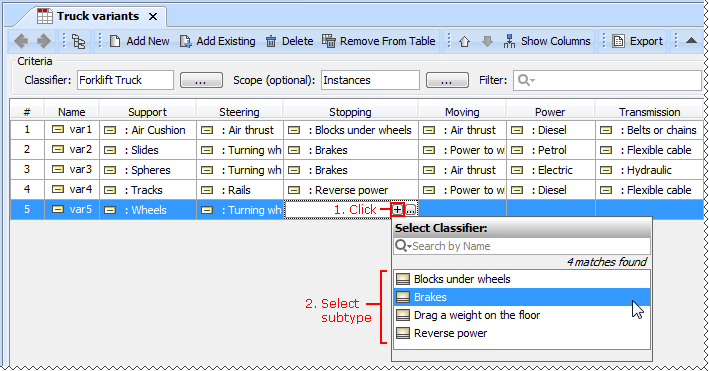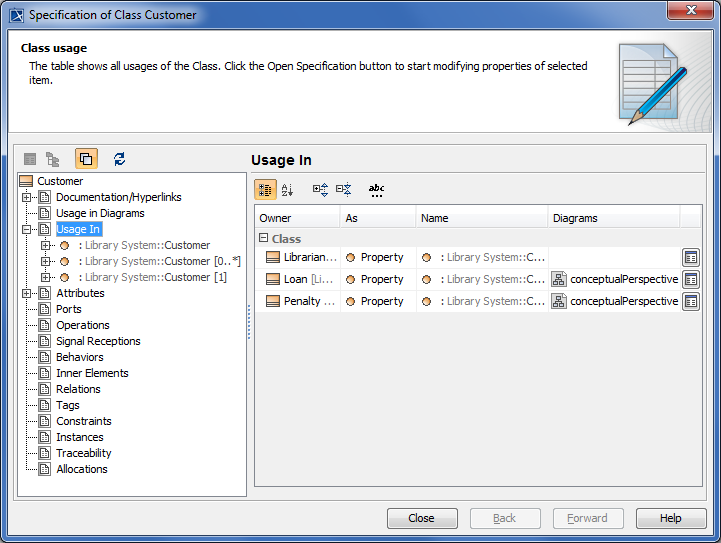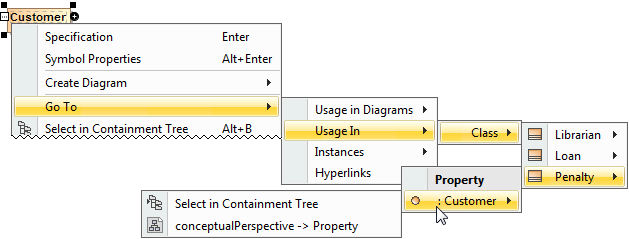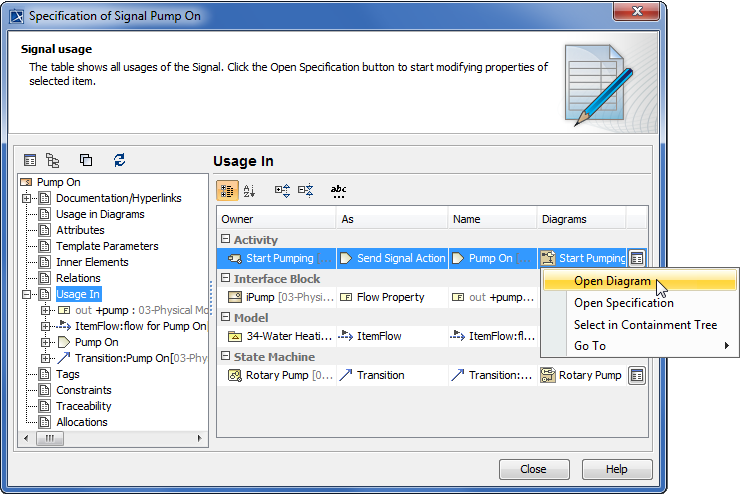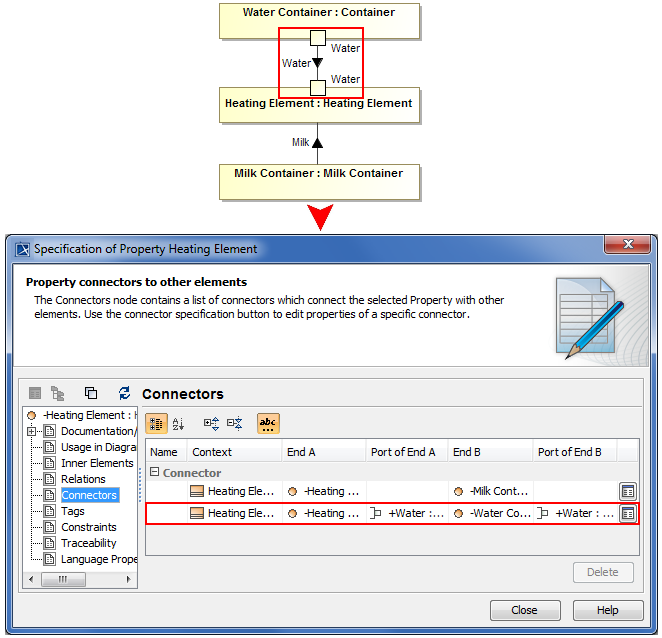When you copy a listed text, each item of this list becomes a new named element in your model (to simplify the creation, basic numbering and bullets are not reproduced in the model).
Elements can be created either in the Containment tree or on the diagram pane, as you can see in the following figures.
When you copy a table, each row becomes the corresponding element with its properties. If elements already exist in the model, the information updates.
The latest version of the product includes the solution! Now you can attach any type of file to your project simply by dragging the file icon from the file system to the Model Browser. The particular file version becomes embedded in this project. The contents of the attached file can be modified and the changes are instantly saved to the project.
Attached files can be:
- Hyperlinked from model elements.
- Inserted into rich text format (HTML) and displayed on diagrams (image files only).
- Included in reports.
- Reused in other projects.
Report templates from the local report templates folder can be attached to your project too. For this, use the new functions of the Report Wizard dialog.
Transferring Projects between Consciously Disconnected Environments
Teamwork Servers, which run in consciously disconnected or secured environments, can still exchange projects!
MagicDraw Teamwork Server 18.1 supports transferring project data from one Teamwork Server to another by using any external storage device, such as CD, DVD, hard disc, or flash memory device. The updated version of the shared project can be transferred back to the sharing server and smoothly merged with the original project version. Furthermore, the same project version can be given to several contributors simultaneously, and the contributions to the model they make can be successfully merged as well.
Elements you can create depend on the selected Element Type and Relation Criterion.
TIP! To create elements faster and more easily:
- Select the element and press Insert (Cmd+I for Mac users) to decompose it.
- Type element name and press Ctrl+Enter to create the element of the same type.
Smarter diagram layout
- When drawing a new path, the layout now overcomes the path labels.
- State Machine diagrams now look better and are easier to read. Plus, the unwanted back loops are eliminated.
- Symbols, created by dragging a group of elements from the Model Browser, are now arranged on the diagram pane as follows:
- In a grid, if there are no paths.
- In the Quick Diagram Layout, if there paths among shapes.
- In a grid, if there are no paths.
Appropriate layouts are applied for displaying parts on a structured classifier shape, if the Layout Parts check box is previously selected in the Display Parts dialog.
Simplified search options
Changing search options in the Quick Find and Element Selection dialogs as well as in autocompletion lists is now easier and more efficient due to the following changes:
- Search phrase specific options, such as one for turning on/off matching anywhere, are now available on a separate menu. In earlier versions, those options resided together with scope filter options.
- Filter options are now available on the button menu and can be applied on the search scope or removed from it with a single click.
- Options are now commands with meaningful names, but not buttons as in earlier versions. It's now easier to find a desired option.
More efficient synchronization
Keep your model valid and synchronized with your changes! The new synchronizations are introduced and the main element properties are now synchronized. In addition, the solving of the broken synchronization has been enhanced.
- The following elements are now synchronized:
- Attribute of Signal is synchronized with Pin of Send Signal or Pin of Accept Event Action.
- Attribute of Signal is synchronized with Argument of Message.
- Parameter of Behavior is synchronized with Parameter of Signal Reception.
- The following element properties are now synchronized:
- If Pin has no flows connected, Pin direction is converted according to direction specified in Parameter. The same works in the opposite scenario when direction of Parameter changes.
- Pin multiplicity is synchronized according to Parameter multiplicity.
- When a new Activity Parameter Node is created in an Activity, the Activity Parameter Node symbol is automatically represented on the Activity diagram frame.
- When solving the broken synchronization, you can choose the direction of the synchronization. For example, when fixing the synchronization between Parameters (Activity) and Pins (Call Behavior Action) you can select to synchronize in one of the following directions:
- Pins (Call Behavior Action) by Parameters (Activity)
- Parameters (Activity) by Pins (Call Behavior Action)
Informative Rake icon
Follow and double-click the symbol with the rake icon for faster navigation in the model! The decomposition of model elements can be represented by the rake icon which indicates a reference to a more elaborated diagram.
The rake icon automatically appears on:
- Call Behavior actions that can refer to another Activity diagram.
- Interaction Uses that can refer to another Sequence diagram.
- Packages that can refer to another Package diagrams.
- Parts that can refer to another Internal Block diagram.
- Use cases can be realized by other behavior diagrams such as Activity, State Machine and Sequence. The rake icon is not shown by default on the element.
The rake icon is not shown by default on the element. To show it, set the Show Rake Icon property value to true in the Symbol Properties dialog.
Composite Instances creation in Instance Tables
The Instance Table UI was improved to allow easy and fast creation of composite instances. Just click the Create Instance Specification button in the slot value cell and create an instance of the slot type instantly or choose from available subtypes.
Element usage traceability
The traceability of the Class, Signal, and Instance elements is much easier now! There are two ways to inspect those element usages in your model:
- For the Class and Signal elements:
- On the left of the Class or Signal Specification window, click Usage In.
- From shortcut menu of the Class or Signal, choose Go To > Usage In.
- For the Instance element:
- On the left of the Classifier Specification window, click Instances.
- From shortcut menu of the Classifier, choose Go To > Instances.
Class usage traceability
You can now trace the Class, when it is used as:
- Representer of the partition
- Part
- Representer of the lifeline
- Type for instances
- State activity
- Action
Signal usage traceability
You can trace the Signal, when it is used:
- In Trigger on Transitions or Accept Event Actions
- As Item Property type
- As Flow Property type
- In Send Signal Action or Broadcast Action
- In Sequence message
Instance usage traceability
Trace all direct and indirect Instances of your Classifier.
Part connections via Ports traceability
Indirect Part connections via Ports are now collected in the Connectors property group of the Part's Specification window. Inspect the list of connectors and modify their properties.
Highlighting of validation rule failures in tables
Now the results of validation rule failures are marked in tables.
- In the Generic Tables, the entire row is marked.
- In the Instance Tables, either a cell, or an entire row is marked. A cell is marked in the case of a faulty slot value. The entire row is marked in the case of a faulty instance.
UML support
- Optional Port is now identified by the phrase via <port name> in the name string on shapes of the following elements: Call Operation Action, Call Behavior Action, Send Signal Action, Send Object Action, Broadcast Signal Action, and Start Object Behavior Action.
- Body of an Opaque Behavior can now be optionally displayed instead of its name on the State or Transition shape, when this Opaque Behavior is used as Entry/Exit/Do Behavior of State or Effect of Transition.
Other News
Conceptual changes in modules
Starting from this version, module is referred as a used project. Keywords "used project" and "project usage" replace the keyword "module" everywhere in MagicDraw UI.
Miscellaneous
- Easily create a Behavior for the Operation. With the new Create Method command on the shortcut menu of the Operation and the Signal Reception, you can create a Behavior (and diagram) faster.
- With the new Display Inner Elements command on the shortcut menu of the State Machine diagram, you can display the shapes of State Machine inner elements faster. The same command is available on the shortcut menu of the Composite State symbol, Activity diagram, and Structured Activity Node symbol.
- Activity diagram created under the Activity now instantly displays all inner elements on this diagram. The same is valid when creating a State Machine diagram under the State Machine.
- Any inherited part can now be quickly redefined directly in the Composite Structure diagrams. Select Refactor > Redefine To, choose a compatible subtype, and let this job be done for you. A new part redefining the original one will be created and graphically replaced in the diagram with all ports and connectors remaining in their places.
- MagicDraw no longer forces the selection of a Metaclass on a Stereotype creation. You can change the Metaclass later from the stereotype's smart manipulator toolbar.
- Selecting a Stereotype or Metaclass no longer requires using the mouse. Use the Up and Down Arrow keys to walk through the lists, press Ctrl+Spacebar to select a desired item, and then press Enter to apply the selected Stereotype or Metaclass.
- Derived properties created using simple navigation operations are now editable.
- The position of text within a shape can be set to the top, center, or bottom by using a new Text Vertical Position property in the Symbol Properties dialog.
- Multiplicity value of an association end can now be edited directly on the diagram pane. Just select the multiplicity area and press F2 to switch it to the edit mode. Then press Ctrl+Spacebar or Ctrl+Backspace to see available suggestions and choose one of them or type a new value.
- Standard and custom subtypes of the selected element type can now be optionally included into search results.
For example, if you need to search for packages as well as for profiles, models, smart packages, and other custom subtypes of the Package, select the new Include Subtypes check box on the Select Element Type dialog after you choose the Package as element type. - Table export to a Microsoft Excel worksheet was improved, and multiline textual values are no longer stripped in the worksheet, if they are stripped in the table - actual, but not displayed data is exported.
- When working with a server project, you can now choose whether to ignore validation rule failures just for you or for all users contributing to that server project.
- Foreign, non-editable projects transferred from other servers can now have domestic, editable branches on the current server.
File format changes
File format reflects changes made in UML metamodel.
Open API changes
UML metamodel related changes
- Removed associations:
- parameter between ValueSpecification and Parameter
- parameter between Pin and Parameter
- Added associations:
- syncElement between two Elements
IntelliJ IDEA project for MagicDraw development
An IntelliJ IDEA project with modules for developing two sample plugins was pre-configured and can be found in <MagicDraw 18.1 installation directory>/openapi/ide.
